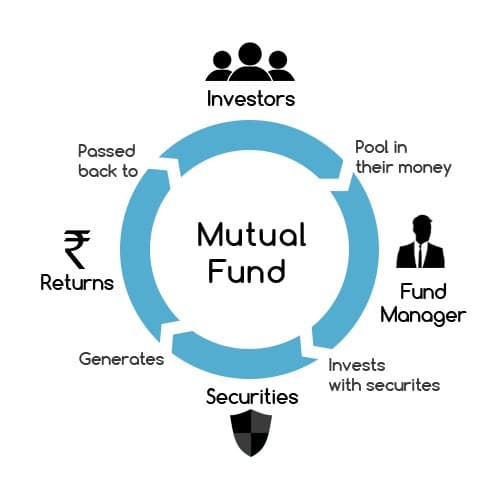
Investment in mutual funds is easy as it is generally considered safer, more stable investments and provides ample opportunities for aggressive wealth creation. You just need to complete one time formalities and transact hassle-free. But they also carry certain risk like other investments. Therefore, it’s very important to have proper knowledge before investing! One should compare risk and expected yields after adjusting tax before taking any investment decision.
For beginners, mutual funds turn out to be the best investment type. How?
- Diversification is the main key term as mutual funds invest in the number of companies. Thus holding a variety of several different securities, rather than just a few. This reduces risk.
- Comparing to other investment types, mutual funds are a relatively less expensive way to invest compared to directly investing in capital markets.
- Bad deliveries, delayed payments and unnecessary follow up with brokers and companies: all are avoided.
- Mutual funds are managed by experienced and skilled professionals who analyses the performance and prospects of companies. This help investors to buy and sell with no worries as money is in the right hands.

Ways To Invest In Mutual Fund
There are different ways to invest in a mutual fund which is listed below.
-
Offline Investment (Fund House)
You can visit the mutual fund branch office with the following documents and their copies in your hands.
- Passport Size photograph
- Proof of Identity
- Proof of Address
- Cancelled Cheque Leaf
-
Offline Investment (Broker)
A mutual fund broker will help you in deciding the investment plan with risk and returns. Complete guidance will be provided including the features of various schemes. A fee will be charged which will be deducted from the total investment amount.
-
Through Online Website Or App
Various investment portals provide you to invest in mutual funds online which is considered fast, simple and convenient. KYC (know-your-client) process is just required to be done for which PAN and Aadhaar number is required.
However, it has limitations too. You can invest only up to ₹ 50,000 per fund house each year. But if your investment amount is more than ₹ 50,000, you compulsory have to opt for physical KYC or a biometric KYC. Verification of bank account details is also important here. For instance, FundsIndia.com and Clearfunds.com instantly deposit ₹ 1 in your bank account to verify your ownership of the same.
How To Choose A Right Mutual Fund?
If you don’t have much knowledge of equity markets, you can go for SIP (Systematic Investment Plan) with a small investment of ₹ 500 in mutual funds. After 6-7 months, you will gain confidence and feel comfortable in investing. Then raise the investment amount per month in the line of your financial goals. SIP done for the short term will not be of much help. It’s better to stay long.
We advise you to use a SIP planner which will help you out in understanding how much money you will get in existing SIP. Or in other ways, you will be able to know how much amount you need to invest regularly to meet your financial goal.
The Best Mutual Funds for Beginners are:
| Category | AUM | Date of Inception | |
| 1. Franklin India Equity Fund | Equity Multicap | Rs 11,770 crore | January 1, 2013 |
| 2. ICICI Prudential Equity and Debt Fund | Aggressive Hybrid Fund | Rs 26,129 crore | November 3, 1999 |
| 3. SBI Bluechip Fund | Equity Large Cap | Rs 22,217 crore | Feb 14, 2006 |
| 4. Aditya Birla Sun Life Balanced Advantage Fund | Dynamic Asset Allocation | Rs 2,836 crore | April 25, 2000 |
Debt mutual funds are perfect for individuals who are in the 50s-60s. These mutual funds are like government securities with minimum risk.
Type Of Returns From Mutual Fund And How It Is Taxed In India?
There are two types of returns an investor can get in a mutual fund.
- Capital Appreciation, and
- Dividends
Therefore, it’s very important to select any one: either a growth plan or a dividend plan. Under a dividend plan, the dividend earned by the investors is tax-free in the hands of the investor. In case of a growth plan, capital gains that apply to the units that are sold at a profit.
If we talk about equity mutual funds, there is no tax liability. But, if you sell your equity mutual fund before a period of one year, there would be a tax of 15 per cent.
Another category of funds is ELSS where investment is exempt to a limit of Rs 1.5 lac per annum under income tax act. The returns are ranging from 8 to 15% with a lock-in period of 3 years. Some good funds under this scheme are HDFC tax saver, Franklin tax saver, Axis long term, Mirae Asset tax plan, DSP black rock, Aditya Birla.
Tip: Before investing in any mutual fund, always check the fund’s performance ranking, it’s total expense ratio, do the ratio analysis or check out in trusted websites. Also, check the scheme asset size and fund manager tenure and experience. Above all-expense ratio is an important parameter as high expense ratio affects the fund’s return.
